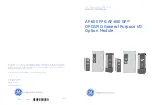
8
9
2VV.
Creating innovative solutions for you and your business since 1995.
ver.1 31-05-21
6. INSTALLATION
6.1 CHOOSING THE PLACE
It is recommended that installation of a ventilation
system be pepared by an HVAC designer
TECHNICAL INFORMATION
The unit is designed to be operated in a dry indoor
environment (relative humidity not exceeding 80%)
and at an ambient temperature in the range from
+5°C up to +40°C.
The unit is designed for transporting standard at
-
mospheric air that is free of dust, grease, chemical
emissions and other impurities.
Condensation within the unit:
If the unit is placed in an attic space (temperatures may
approximate outdoor temperatures), it is necessary for
the unit to run continuously. If the unit can be turned off
manually by the user or an automatic timer, it is necessa
-
ry to install airtight dampers with emergency functioning
on the intake and exhaust ducts. The dampers will ensure
that no air from the warm parts of the building will flow
through the unit (stack effect). If no dampers have been
installed, there will be a risk of condensation within the
unit and exterior ducts at the time the unit is deactivated.
This may also result in cold exterior air flowing into the
building. In that case condensation can also occur within
the intake and exhaust ducts or even in valves placed in
rooms. If the unit is not running for a long period of time
during winter, the intake and exhaust ducts should be
closed so that the above effect does not occur after this
period. If the unit is placed in a moist area (e.g. a laundry
room), condensation On the external parts of the unit may
occur when combined with low exterior temperatures. If
condensation occurs outside the unit, increase the venti
-
lation in the surroundings of the unit.
40
40
The unit is not designed to filter air containing combus
-
tible or flammable particles, chemical fumes, coarse dust,
carbon, grease, poisons, bacteria, etc.
The IP protection level of the unit in the ducts is IP 20









































